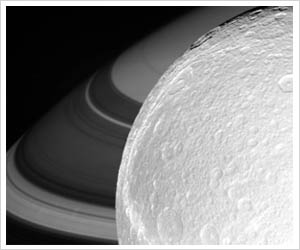Saturn’s moon Enceladus may host a salty ocean
 London, June 25 : A new research by European scientists has provided evidence that an enormous plume of water spurts in giant jets from the south pole of Saturn’s moon Enceladus is fed by a salty ocean, a discovery that may have implications for the search for extraterrestrial life.
London, June 25 : A new research by European scientists has provided evidence that an enormous plume of water spurts in giant jets from the south pole of Saturn’s moon Enceladus is fed by a salty ocean, a discovery that may have implications for the search for extraterrestrial life.
The Cassini spacecraft made a surprising discovery about Saturn’s sixth largest moon, Enceladus, on its exploration of the giant ringed planet in 2005.
Enceladus ejects water vapor, gas and tiny grains of ice into space hundreds of kilometers above the moon’s surface.
Enceladus orbits in Saturn’s outermost “E” ring. It is one of only three outer solar system bodies that produce active eruptions of dust and vapor.
Moreover, aside from the Earth, Mars, and Jupiter’s moon Europa, it is one of the only places in the solar system for which astronomers have direct evidence of the presence of water.
New understanding of how this plume is produced was revealed in 2008 by Juergen Schmidt of the University of Potsdam, Germany, and Nikolai Brilliantov of the University of Leicester, and colleagues.
They explained how the water vapor jets are blasted out much faster than the dust particles. To work their theory required that Enceladus has an ocean of liquid water below its surface.
The same team, working with Frank Postberg of the University of Heidelberg and the Max Planck Institute for Nuclear Physics, in Heidelberg, has now found the direct experimental evidence for the presence of this ocean, which was previously lacking.
Current theories of satellite formation suggest that should a moon have a deep liquid ocean in contact with the body’s rocky core, for many millions of years, then it should be a salty ocean.
The team now reports the detection of sodium salts among the dust ejected in the Enceladus plume.
Postberg and colleagues have studied data from the Cosmic Dust Analyzer (CDA) onboard the Cassini spacecraft and have combined this data with laboratory experiments.
They have shown that the icy grains in the Enceladus plume contain substantial quantities of sodium salts, hinting at the salty ocean deep below.
The theory, proposed by Brilliantov and Schmidt, has allowed the team to relate the detected salt in the CDA with the likely concentration in the water vapor above the ocean, which proves the consistency of the experimental data.
The results of the study imply that the concentration of sodium chloride in the ocean can be as high as that of Earth’s oceans and is about 0.1-0.3 moles of salt per kilogram of water. (ANI)